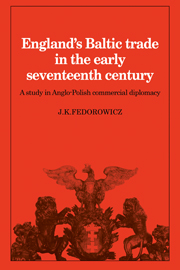 England's Baltic Trade in the Early Seventeenth Century
England's Baltic Trade in the Early Seventeenth Century Published online by Cambridge University Press: 05 November 2011
The purpose behind English mediation
The deteriorating military situation in Germany, commercial blockade in the Baltic, and renewed depression in England combined to arouse the English government from its lethargy. The year 1629 saw Habsburg armies besieging the Baltic port of Stralsund while English shipping to the Eastland was reduced to a trickle. In England itself wool prices fell, trade decayed, and a parliamentary crisis over tunnage and poundage paralysed the government. In addition to the German and Baltic wars, England was trying to extricate itself from futile conflicts with France and Spain that merely added to the general insecurity which was having a fatal effect on the nation's livelihood. Whatever its weaknesses, the government of Charles I could no longer afford to ignore these problems; the decision to intervene diplomatically in the Baltic was simply the logical response to the host of ills that had been allowed to accumulate for so long.
In a sense, the Baltic could be considered a key to the solution of everything else. By successfully mediating in the war between Sweden and Poland, the English government would free the ambitious Gustav Adolf to save German Protestantism by direct intervention, would restore peace and free trade to the Baltic, and this in turn would revive demand for English cloth and renew Baltic supplies of important commodities, both of which would alleviate the depression in England itself. Successful mediation might add prestige to Charles's government and not only deflect some Parliamentary criticisms but also place England in a stronger position to negotiate with France and Spain. On all counts, therefore, successful mediation promised fair returns for a minimal investment.
To save this book to your Kindle, first ensure [email protected] is added to your Approved Personal Document E-mail List under your Personal Document Settings on the Manage Your Content and Devices page of your Amazon account. Then enter the ‘name’ part of your Kindle email address below. Find out more about saving to your Kindle.
Note you can select to save to either the @free.kindle.com or @kindle.com variations. ‘@free.kindle.com’ emails are free but can only be saved to your device when it is connected to wi-fi. ‘@kindle.com’ emails can be delivered even when you are not connected to wi-fi, but note that service fees apply.
Find out more about the Kindle Personal Document Service.
To save content items to your account, please confirm that you agree to abide by our usage policies. If this is the first time you use this feature, you will be asked to authorise Cambridge Core to connect with your account. Find out more about saving content to Dropbox.
To save content items to your account, please confirm that you agree to abide by our usage policies. If this is the first time you use this feature, you will be asked to authorise Cambridge Core to connect with your account. Find out more about saving content to Google Drive.